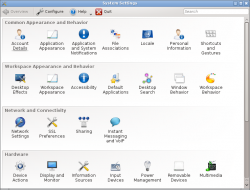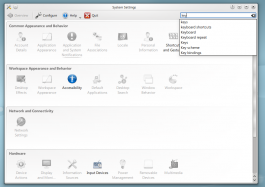System Settings/ro: Difference between revisions
Created page with "==Căutare==" |
Created page with "'''System Settings''' are o funcţie de căutare pentru a ajuta la căutarea şi eliminarea unei setări.Pur şi simplu tastaţi un cuvânt cheie în câmpul de căutare din bara..." |
||
| Line 14: | Line 14: | ||
==Căutare== | ==Căutare== | ||
'''System Settings''' | '''System Settings''' are o funcţie de căutare pentru a ajuta la căutarea şi eliminarea unei setări.Pur şi simplu tastaţi un cuvânt cheie în câmpul de căutare din bara de unelte şi Setările de Sistem vor afişa module ce conţin cuvântul cheie şi le ascund pe cele care nu conţin.Modulele Setărilor de Sistem pot fi de asemenea găsite în '''[[KRunner|KRunner]]'''. | ||
:{|class="tablecenter" | :{|class="tablecenter" | ||
Revision as of 18:25, 24 December 2010
Caracteristici
- Centrul de Control pentru setările platformei globale KDE
- Personalizează-ţi şi gestionează-ţi desktop-ul într-o locaţie convenabilă
- Funcţia de căutare ajută la restrângerea setărilor probabile.
Căutare
System Settings are o funcţie de căutare pentru a ajuta la căutarea şi eliminarea unei setări.Pur şi simplu tastaţi un cuvânt cheie în câmpul de căutare din bara de unelte şi Setările de Sistem vor afişa module ce conţin cuvântul cheie şi le ascund pe cele care nu conţin.Modulele Setărilor de Sistem pot fi de asemenea găsite în KRunner.
Categories
Common Appearance and Behavior
Account Details

Configure your user information, password and paths. You can also configure your Social Desktop providers. Application Appearance

Configure your applications style, colors, icons, fonts and emoticons.
Hardware
Input Devices

Configure your keyboard, mouse and joystick.
System Administration
Login Screen

Configure the login manager (KDM). Startup and Shutdown

Configure your system behavior when starting up or shutting down.
Mouse Gestures
- KDE SC version 4.4.4
The place where you start is ""
Enabling mouse gestures
In the bottom left corner of the window there is a button. Make sure that the checkbox is checked. Set the timout as you see fit. The mouse button might be different for you, I chose 3 for using the right mouse button. If you want input actions to be enabled automatically, check the "Start the input Actions daemon on login" above.
Creating the Mouse gestures actions group
Right click on the left pane (in an empty area under the list of action groups) and choose , rename that group to "Mouse Gestures" and check the checkbox attached to its name.
Creating a new mouse gesture
From now on I will assume that the new group is called "Mouse Gestures". Right click on and choose (here there are three options but I didn't manage to work with "Send Keyboard Input") using "Command/URL" or "D-Bus Command" you will need to create a gesture and bind an action to it.
To create the gesture
Click on your and select the tab. in the bottom of the screen there is an button (click it). In the box that just opened draw your gesture using the left mouse button.
To bind an action
if you chose simply enter that command/url under the tab at the field.
Examples using Command/URL
Close window
This command will let you close the next window you mouse click on.
Command/URL: wmctrl -c :SELECT:
to close the active window
Command/URL: wmctrl -c :ACTIVE:
Translate clipboard content
This command will display a translation of the current clipboard content.
- Required for this are:
- xclip
- libtranslate
'"`UNIQ--syntaxhighlight-00000011-QINU`"'
Replace 'en' and 'he' with the desired source and destination language, if you are not sure, a full list of language codes is available from the ISO 639-2 list.
Examples using D-Bus
If you chose D-Bus, here are few examples.
Finding out what to fill where, is done with the help of the "Launch D-Bus Browser", using that browser you can find what method you wish to call in what application object. Using D-Bus we need to fill some fields, the field name will be regular and the content italic.
Runner
This will display the Runner dialog.
Remote Application: org.kde.krunner
Remote Object: /App
Function: org.kde.krunner.App.display
Audacious next/previous/pause/play/stop/repeat track
Remote Application: org.mpris.audacious
Remote Object: /Player
Function: org.freedesktop.MediaPlayer.Next (replace Next with Prev/Pause/Stop/Play/Repeat)
Audacious PlayPause track
If not playing will play, if playing will pause.
Remote Application: org.mpris.audacious
Remote Object: /org/atheme/audacious
Function: org.atheme.audacious.PlayPause
display the actions pop-up. (I am using that to search and translate words)
Remote Application: org.kde.klipper
Remote Object: /klipper
Function: org.kde.klipper.klipper.showKlipperManuallyInvokeActionMenu



